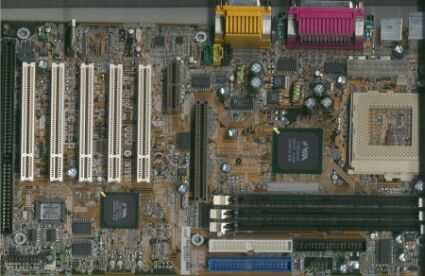12 Socket 370 Motherboards using VIA's Apollo Pro 133A
MSI MS-6309
Board Revision: 1.0
BIOS Version: 0314F (March 15, 2000)
MSI's package contains one 40pin and one 80pin IDE cable, FDD cable, an excellent manual, the driver CD and a little booklet, which is meant to explain the D-LED feature. Hardware, BIOS and setup are elaborately explained. MSI uses the AMI BIOS, which also included all CPU setup items (FSB, multiplier and Vcore). I think, MSI originally wanted to use DIPswitches, as there's a description on the motherboards - without any DIP switches being present.
Those settings can be found in 'Hardware Monitor Setup'. 66, 79, 85, 87.5, 92, 95, 100, 110, 115, 120, 124, 129, 133 and 138 MHz FSB speed can be chosen. Particularly 87 and 92 MHz are quite uncommon and perfectly suited for Celeron overclocking. The CPU voltage can be set between 1.50 and 1.85 for Coppermine and the new Celeron processors at 566 and 600 MHz, while you may chose between 2.0 and 2.8V for the old Celerons up to 533 MHz.
The SDRAM frequency can be 100 or 133 MHz in case a 133 MHz FSB CPU is working or 66/100/133 MHz in case you are using a 100 MHz FSB processor. 66 MHz processors can make use of 66 or 100 MHz SDRAM clock speed.
There's an item in the BIOS which is very interesting for overclockers: After enabling the item ClkGen Spread Spectrum, you get the option to rise the FSB speed some more. 143, 147, 152, 154, 157, 159, 162, 166, 171, 180, 190 and even 200 MHz can be set. Please consider that the VIA chipset usually does not bear more thatn approx. 155 MHz clock speed, so every setting which exceeds 166 MHz may look great, but most likely will fail. We got lock ups even at 162 MHz FSB.
D-LED consists of four LEDs, which signalize the system state during boot up. If your system should hang, you will be able to trace the reason. The board also comes with two more USB ports, offering a total of four. Once again, you will have to obtain an adapter cable yourself.
Get Tom's Hardware's best news and in-depth reviews, straight to your inbox.
MSI found quite a smart battery retention system. It is not lying in a special socket, bzt just plugged in into a retention mechanism making it much easier to exchange the battery. Of course that won't be necessary too often, but it's the small things that make your life easier!
After a look at our benchmarks you will see that the MSI board is not amonst the fastest, but still reaches the performance that we expect. I think the results could be better if the BIOS featured some more options to alter the memory timings.

Patrick Schmid was the editor-in-chief for Tom's Hardware from 2005 to 2006. He wrote numerous articles on a wide range of hardware topics, including storage, CPUs, and system builds.
